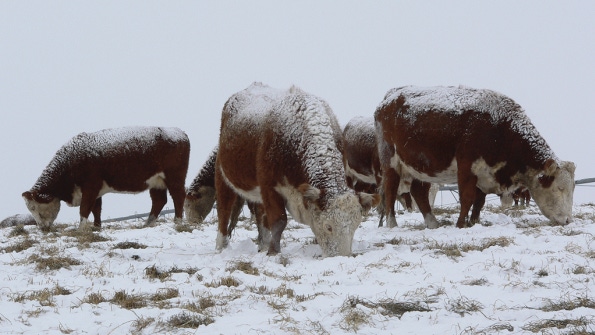Cattle will eat snow to obtain water, but don’t rely on it exclusively.
October 27, 2016

In some extensive pasture operations where water sources are far apart or inadequate, certain areas can be used for winter grazing when there is adequate snow cover, since cattle will lick/eat snow. “Data from a number of studies show that cattle will and can meet their water requirement with snow,” says Terry Mader, Mader Consulting, Gretna, Neb., and professor emeritus, University of Nebraska-Lincoln.
“In some areas of open range they have to depend on snow. The important thing about utilizing snow is making sure the animals are in a positive energy balance. If they are not getting enough nutrients to maintain body temperature, the amount of snow they must consume can become an issue. Depending entirely on snow for water is not ideal, but will work if cattle can’t get to a water supply for a day or two or the water is frozen.”
Julie Walker, Extension beef specialist at South Dakota State University, says we know cows can eat snow, but some don’t eat snow readily. “We don’t really know how to teach cows to eat snow,” she says. “They generally learn by mimicking other cows or their mothers, if calves are wintering with their mothers. If you simply put cattle out on winter pasture and they are not accustomed to eating snow, many are slow to learn,” she says.
“They should always have a water source. Some cows may not come to water every day; they choose to stay out and graze and lick snow, but it’s there when they want it. Some cows only come in for water every other day or so because snow consumption provides much of what they need,” says Walker.

Breathtaking photos of winter on the ranch
The first snow hit parts of the Midwest this week. Mentally prepare for the winter wonderland with these stunning photos. See photos here.
“If cattle are going to utilize snow, it can’t be crusted,” says Charles Stoltenow, Extension veterinarian at North Dakota State University (NDSU). “They must be able to scoop it up with their tongue, so if it’s gone through a thaw-freeze cycle and crusted, cattle have a hard time consuming enough snow. If they have to chew up crusted snow, they get abrasions in their mouth, which makes it more painful and difficult to graze. This results in decreased feed intake as well as decreased water intake so it becomes a vicious cycle,” he says.
Trey Patterson, CEO of the Padlock Ranch Company in Ranchester, Wyo., says their operation winters a lot of cows on dryland pastures. “Some cattle may be on pastures that are poorly watered, or water quality is marginal. In those situations, cattle sometimes rely on snow, but not as the sole source of water. In our experience, we found more variation in winter performance if you have to rely solely on snow, so we always provide water, as well,” he says.
“Feed intake and water intake are positively correlated. When it gets cold, cattle need more feed and more water. Some cattle will not eat enough snow to meet water requirements, and lose weight,” says Patterson.
You might also like:
15 favorites from fall photos on the ranch
4 questions to ask before marketing 2016 calves
9 new pickups for the ranch in 2016
Seven keys to ranch profitability
How to cull the right cow without keeping records
Burke Teichert's top 5 tips on bull selection
Young ranchers, listen up: 8 tips from an old-timer on how to succeed in ranching
You May Also Like



